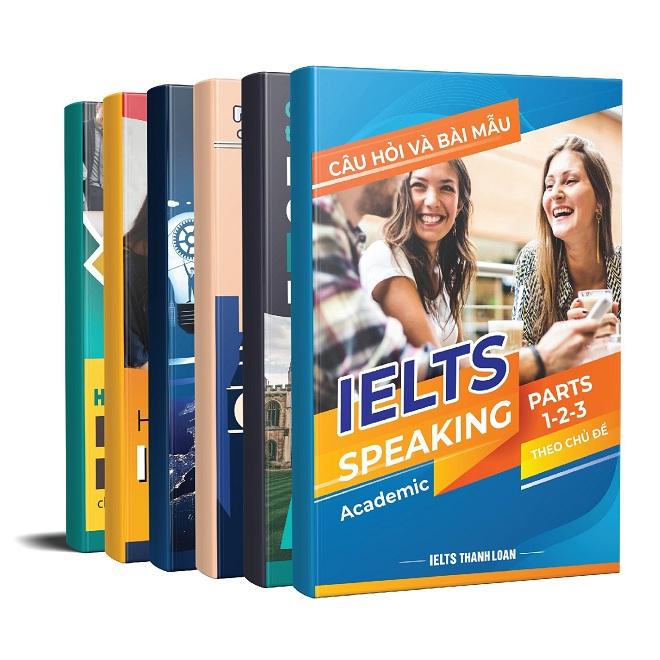IELTS Reading có phải là phần thi khó nhất đối với bạn? Cùng cô Thanh Loan thử thách bản thân với đề thi The Official Guide to IELTS – Test 6 và tham khảo phần dịch đề cùng phân tích đáp án chi tiết. Nếu bạn cần cải thiện điểm số nhanh chóng, các khóa học luyện thi IELTS 1 kèm 1 và khóa học luyện thi IELTS cấp tốc,… tại IELTS Thanh Loan sẽ giúp bạn đạt kết quả tốt nhất.
Passage 1: Why Are Finland’s Schools Successful?
A
At Kirkkojarvi Comprehensive School in Espoo, a suburb west of Helsinki, Kari Louhivuori, the school’s principal, decided to try something extreme by Finnish standards. One of his sixth-grade students, a recent immigrant, was falling behind, resisting his teacher’s best efforts. So he decided to hold the boy back a year. Standards in the country have vastly improved in reading, math and science literacy over the past decade, in large part because its teachers are trusted to do whatever it takes to turn young lives around. ‘I took on Besart that year as my private student,’ explains Louhivuori. When he was not studying science, geography and math, Besart was seated next to Louhivuori’s desk, taking books from a tall stack, slowly reading one, then another, then devouring them by the dozens. By the end of the year, he had conquered his adopted country’s vowel-rich language and arrived at the realization that he could, in fact, learn (Q1).
- principal /ˈprɪnsəpl/ (noun): hiệu trưởng
- extreme /ɪkˈstriːm/ (adj): đặc biệt, không bình thường
- turn something around (phrasal verb): thay đổi hoàn toàn
- take on somebody (phrasal verb): nhận thuê, nhận làm trò
Tại Trường Toàn diện Kirkkojarvi ở Espoo, ngoại ô phía tây Helsinki, Kari Louhivuori, hiệu trưởng của trường, đã quyết định thử một điều gì đó đặc biệt theo tiêu chuẩn Phần Lan. Một trong những học sinh lớp sáu của ông, một người mới nhập cư, đã bị tụt lại phía sau, chống lại những nỗ lực hết mình của giáo viên. Vì vậy, ông quyết định giữ cậu bé lại một năm. Các tiêu chuẩn ở quốc gia này đã được cải thiện đáng kể về khả năng đọc, làm toán và khoa học trong thập kỷ qua, một phần lớn là do các giáo viên của nước này được tin tưởng sẽ làm bất cứ điều gì cần thiết để thay đổi cuộc sống của trẻ. Louhivuori giải thích rằng ‘tôi đã nhận Besart vào năm đó làm học sinh riêng của mình’. Khi không học khoa học, địa lý và toán học, Besart ngồi cạnh bàn của Louhivuori, lấy sách từ một chồng cao, đọc chậm rãi hết cuốn này đến cuốn khác, rồi đọc ngấu nghiến hàng chục cuốn. Vào cuối năm đó, cậu ấy đã chinh phục được ngôn ngữ giàu nguyên âm của đất nước này và nhận ra rằng trên thực tế, cậu ấy có thể học được.
B
This tale of a single rescued child hints at some of the reasons for Finland’s amazing record of education success. The transformation of its education system began some 40 years ago but teachers had little idea it had been so successful until 2000. In this year, the first results from the Programme for International Student Assessment (PISA), a standardized test given to 15-year- olds in more than 40 global venues, revealed Finnish youth to be the best at reading in the world. Three years later, they led in math. By 2006, Finland was first out of the 57 nations that participate in science. In the latest PISA scores, the nation came second in science, third in reading and sixth in math among nearly half a million students worldwide (Q2) (Q7).
Câu chuyện về một đứa trẻ được ‘giải cứu’ này gợi ý một số lý do giải thích cho thành công giáo dục đáng kinh ngạc của Phần Lan. Sự chuyển đổi hệ thống giáo dục của nó đã bắt đầu cách đây khoảng 40 năm nhưng các giáo viên ít biết rằng nó đã thành công như vậy cho đến năm 2000. Trong năm này, kết quả đầu tiên từ Chương trình Đánh giá Học sinh Quốc tế (PISA), một bài kiểm tra tiêu chuẩn cho những đứa trẻ 15 tuổi tại hơn 40 địa điểm trên toàn cầu, cho thấy giới trẻ Phần Lan đọc sách giỏi nhất thế giới. Ba năm sau, họ dẫn đầu về môn Toán. Đến năm 2006, Phần Lan là quốc gia đầu tiên trong số 57 quốc gia tham gia vào lĩnh vực khoa học. Trong điểm số PISA mới nhất, quốc gia này đứng thứ hai về khoa học, thứ ba về đọc và thứ sáu về Toán trong số gần nửa triệu học sinh trên toàn thế giới.
C
In the United States, government officials have attempted to improve standards by introducing marketplace competition into public schools (Q3). In recent years, a group of Wall Street financiers and philanthropists such as Bill Gates have put money behind private sector ideas, such as charter schools, which have doubled in number in the past decade. President Obama, too, apparently thought competition was the answer. One policy invited states to compete for federal dollars using tests and other methods to measure teachers, a philosophy that would not be welcome in Finland. ‘I think, in fact, teachers would tear off their shirts,’ said Timo Heikkinen, a Helsinki principal with 24 years of teaching experience. If you only measure the statistics, you miss the human aspect.’
- attempt to do something /əˈtempt/ (verb): nỗ lực
- philanthropist /fɪˈlænθrəpɪst/ (noun): mạnh thường quân
Tại Hoa Kỳ, các quan chức chính phủ đã cố gắng cải thiện các tiêu chuẩn bằng cách đưa sự cạnh tranh trên thị trường vào các trường công lập. Trong những năm gần đây, một nhóm các nhà tài chính và nhà từ thiện ở Phố Wall như Bill Gates đã bỏ tiền ra hỗ trợ các ý tưởng của khu vực tư nhân, chẳng hạn như các trường bán công, đã tăng gấp đôi số lượng trong thập kỷ qua. Tổng thống Obama cũng nghĩ rằng cạnh tranh là câu trả lời. Một chính sách đã mời các bang cạnh tranh để giành được đô la liên bang bằng cách sử dụng các bài kiểm tra và các phương pháp khác để đánh giá giáo viên, một triết lý sẽ không được hoan nghênh ở Phần Lan. Timo Heikkinen, hiệu trưởng Helsinki với 24 năm kinh nghiệm giảng dạy cho biết: “Tôi nghĩ thực tế là giáo viên sẽ xé áo ra đi. Nếu bạn chỉ đo lường các số liệu thống kê, bạn đã bỏ lỡ khía cạnh con người. ‘
D
There are no compulsory standardized tests in Finland, apart from one exam at the end of students’ senior year in high school. There is no competition between students, schools or regions. Finland’s schools are publicly funded. The people in the government agencies running them, from national officials to local authorities, are educators rather than business people or politicians. Every school has the same national goals and draws from the same pool of university-trained educators. The result is that a Finnish child has a good chance of getting the same quality education no matter whether he or she lives in a rural village or a university town (Q4).
Ở Phần Lan không có bài kiểm tra tiêu chuẩn bắt buộc nào, ngoài một kỳ thi vào cuối năm cuối cấp ba của học sinh. Không có sự cạnh tranh giữa học sinh, trường học hoặc khu vực. Các trường học của Phần Lan được tài trợ công khai. Những người trong các cơ quan chính phủ điều hành chúng, từ quan chức quốc gia đến chính quyền địa phương, là những nhà giáo dục hơn là những người kinh doanh hay chính trị gia. Mọi trường học đều có những mục tiêu quốc gia như nhau và đều có các nhà giáo dục được đào tạo ở trường đại học. Kết quả là một đứa trẻ Phần Lan có cơ hội nhận được nền giáo dục chất lượng như nhau cho dù trẻ sống ở một ngôi làng nông thôn hay thị trấn đại học.
E
It’s almost unheard of for a child to show up hungry to school. Finland provides three years of maternity leave and subsidized day care to parents, and preschool for all five-year-olds, where the emphasis is on socializing. In addition, the state subsidizes parents, paying them around 150 euros per month for every child until he or she turns 17 (Q5). Schools provide food, counseling and taxi service if needed. Health care is even free for students taking degree courses.
- maternity leave /məˈtɜːnəti liːv/ (noun): nghỉ thai sản
- subsidize somebody /ˈsʌbsɪdaɪz/ (verb): trợ cấp
Việc một đứa trẻ mang bụng đói đến trường là điều hầu như chưa từng có. Phần Lan cung cấp ba năm nghỉ thai sản và trợ cấp dịch vụ giữ trẻ ban ngày cho cha mẹ và trường mầm non cho tất cả trẻ em năm tuổi, nơi tập trung vào hoạt động xã hội. Ngoài ra, nhà nước còn trợ cấp cho phụ huynh, trả họ khoảng 150 euro mỗi tháng cho mỗi đứa trẻ cho đến khi trẻ bước sang tuổi 17. Trường học cung cấp dịch vụ ăn uống, tư vấn và taxi nếu cần. Chăm sóc sức khỏe thậm chí còn miễn phí cho sinh viên tham gia các khóa học cấp bằng.
F
Finland’s schools were not always a wonder. For the first half of the twentieth century, only the privileged got a quality education. But in 1963, the Finnish Parliament made the bold decision to choose public education as the best means of driving the economy forward and out of recession (Q6) (Q8). Public schools were organized into one system of comprehensive schools for ages 7 through 16. Teachers from all over the nation contributed to a national curriculum that provided guidelines, not prescriptions, for them to refer to (Q9). Besides Finnish and Swedish (the country’s second official language), children started learning a third language (English is a favorite) usually beginning at age nine (Q10). The equal distribution of equipment was next, meaning that all teachers had their fair share of teaching resources to aid learning (Q11). As the comprehensive schools improved, so did the upper secondary schools (grades 10 through 12). The second critical decision came in 1979, when it was required that every teacher gain a fifth-year Master’s degree in theory and practice, paid for by the state (Q12). From then on, teachers were effectively granted equal status with doctors and lawyers. Applicants began flooding teaching programs, not because the salaries were so high but because autonomous decision making and respect made the job desirable (Q13). And as Louhivuori explains, ‘We have our own motivation to succeed because we love the work.’
- the privileged /ˈprɪvəlɪdʒd/ (noun): những người có đặc quyền
- recession /rɪˈseʃn/ (noun): suy thoái kinh tế
- autonomous /ɔːˈtɒnəməs/ (adj): tự chủ, tự mình
Các trường học của Phần Lan không phải lúc nào cũng là một điều kỳ diệu. Trong nửa đầu thế kỷ XX, chỉ những người có đặc quyền mới có được một nền giáo dục chất lượng. Nhưng vào năm 1963, Quốc hội Phần Lan đã đưa ra quyết định táo bạo khi chọn giáo dục công là phương tiện tốt nhất để thúc đẩy nền kinh tế tiến lên và thoát khỏi suy thoái. Các trường công lập được tổ chức thành một hệ thống trường học toàn diện dành cho lứa tuổi từ 7 đến 16. Bên cạnh tiếng Phần Lan và tiếng Thụy Điển (ngôn ngữ chính thức thứ hai của đất nước), trẻ em bắt đầu học ngôn ngữ thứ ba (tiếng Anh là một ngôn ngữ được yêu thích) thường bắt đầu từ chín tuổi. Tiếp theo là việc phân phối thiết bị đồng đều, có nghĩa là tất cả giáo viên đều có phần tài nguyên giảng dạy công bằng để hỗ trợ việc học. Khi các trường phổ thông được cải thiện toàn diện, các trường trung học phổ thông (lớp 10 đến lớp 12) cũng vậy. Quyết định quan trọng thứ hai được đưa ra vào năm 1979, khi nhà nước yêu cầu mọi giáo viên phải có bằng Thạc sĩ năm thứ năm về lý thuyết và thực hành, do nhà nước chi trả. Từ đó trở đi, các giáo viên có địa vị bình đẳng với bác sĩ và luật sư một cách hiệu quả. Các ứng viên bắt đầu tràn ngập các chương trình giảng dạy, không phải vì mức lương quá cao mà vì quyền tự quyết định và sự tôn trọng khiến công việc trở nên đáng mơ ước. Và như Louhivuori giải thích, ‘Chúng tôi có động lực riêng để thành công bởi vì chúng tôi yêu thích công việc.’
Questions 1-6: Reading Passage 1 has six paragraphs, A-F. Choose the correct heading for each paragraph from the list of headings below. Write the correct number, i-ix, in boxes 1-6 on your answer sheet.
|
List of Headings
|
1. Paragraph A
> When he was not studying science, geography and math, Besart was seated next to Louhivuori’s desk, taking books from a tall stack, slowly reading one, then another, then devouring them by the dozens. By the end of the year, he had conquered his adopted country’s vowel-rich language and arrived at the realization that he could, in fact, learn.
> Cậu bé nhập cư được hiệu trưởng kèm riêng và sau một năm, cậu đã học đươc ngôn ngữ của đất nước này và nhận ra cậu có khả năng học.
> Đáp án: vi. An approach that helped a young learner
2. Paragraph B
> Three years later, they led in math. By 2006, Finland was first out of the 57 nations that participate in science (~ statistical proof of education success). In the latest PISA scores, the nation came second in science, third in reading and sixth in math (~ statistical proof of education success) among nearly half a million students worldwide.
> Đáp án: vii. Statistical proof of education success
3. Paragraph C
> In the United States, government officials have attempted to improve standards by introducing marketplace competition (~ business-model approach) into public schools (~ education).
> Đáp án: i. A business-model approach to education
4. Paragraph D
> The result is that a Finnish child has a good chance of getting the same quality education (~ equality in the Finnish education system) no matter whether he or she lives in a rural village or a university town.
> Xuyên suốt đoạn, tác giả đề cập đến và phân tích việc ở Phần Lan không có cạnh tranh trong giáo dục dẫn đến học sinh có cơ hội giáo dục như nhau.
> Đáp án: iv. Ways in which equality is maintained in the Finnish education system
5. Paragraph E
> Finland provides three years of maternity leave and subsidized day care to parents, and preschool for all five-year-olds… the state subsidizes parents, paying them around 150 euros per month for every child until he or she turns 17.
> Đoạn đề cập đến việc chính phủ Phần Lan hỗ trợ gia đình ở nước này.
> Đáp án: viii. Support for families working and living in Finland
6. Paragraph F
> But in 1963, the Finnish Parliament made the bold decision to choose public education as the best means of driving the economy forward and out of recession.
> Đoạn đề cập đến việc chính phủ Phần Lan quyết định chọn giáo dục công làm chìa khóa đưa đất nước thoát khỏi suy thoái kinh tế và sau đó là một loạt các thay đổi trong hệ thống giáo dục.
> Đáp án: ii. The reforms that improved education in Finland
Questions 7-13: Complete the notes below. Choose NO MORE THAN TWO WORDS AND/OR A NUMBER from the passage for each answer Write your answers in boxes 7-13 on your answer sheet.
The school system in Finland
PISA tests
In the most recent tests, Finland’s top subject was 7…………………
> In the latest PISA scores (~ in the most recent tests), the nation came second in science, third in reading and sixth in math.
> Đáp án: science
History
1963:
A new school system was needed to improve Finland’s 8…………………
> For the first half of the twentieth century, only the privileged got a quality education. But in 1963, the Finnish Parliament made the bold decision to choose public education (~ a new school system) as the best means of driving the economy forward (~ improve Findland’s economy).
> Đáp án: economy
Schools followed 9………………… that were created partly by teachers.
> Teachers from all over the nation contributed to (~ created partly) a national curriculum that provided guidelines, not prescriptions, for them to refer to (~ schools followed).
> Đáp án: guidelines
Young pupils had to study an additional 10…………………
> Besides Finnish and Swedish (the country’s second official language), children started learning a third language (English is a favorite) usually beginning at age nine (~ young pupils).
> Đáp án: language
All teachers were given the same 11………………… to use.
> The equal distribution (~ the same) of equipment was next, meaning that all teachers had their fair share (~ the same) of teaching resources to aid learning.
> Đáp án: equipment/ resources
1979:
Teachers had to get a 12………………… but they did not have to pay for this.
> The second critical decision came in 1979, when it was required that every teacher gain a fifth-year Master’s degree in theory and practice, paid for by the state (~ not have to pay for it).
> Đáp án: Master’s degree/ Masters degree
Applicants were attracted to the 13………………… that teaching received.
> Teachers were effectively granted equal status with doctors and lawyers. Applicants began flooding teaching programs, not because the salaries were so high but because autonomous decision making and respect made the job desirable (~ attracted to).
> Đáp án: respect/ status
Hãy tham khảo Khóa Học IELTS Online qua ZOOM cùng cô Thanh Loan
IELTS Thanh Loan – giáo viên 10 năm kinh nghiệm – trực tiếp đứng lớp, tự tin mang đến khóa học chất lượng nhất, phương pháp giảng dạy cô đọng dễ hiểu, giáo trình tự biên soạn cho lộ trình từ cơ bản đến luyện đề chuyên sâu. Đặc biệt, học viên luôn được quan tâm sát sao nhất, hỗ trợ không giới hạn, thúc đẩy kỷ luật học tập tốt để đạt mục tiêu.
Passage 2: Some Facts and Theories about Flu
The flu, more properly known as influenza, takes its name from the fact that it is so easily transmitted from person to person (influenza is the Italian word for ‘influence’). Usually, contamination occurs through direct contact with secretions from an infected person. Its spread is also possible from contaminated airborne particles, such as those that occur when someone coughs or sneezes (Q14). However, it should be made clear that the risk is not great from simply being in the same room as an infected person (Q21), since the flu virus, unlike other respiratory viruses, does not dissolve in the air. Within 4-6 hours of someone catching the flu, the virus multiplies in infected cells and the cells burst, spreading the virus to other cells nearby.
- contamination /kənˌtæmɪˈneɪʃn/ (noun): lây nhiễm
- airborne /ˈeəbɔːn/ (adj): được mang bởi không khí
Bệnh cúm có tên là “influenza” là vì nó rất dễ lây truyền từ người sang người (“influenza” là từ tiếng Ý có nghĩa là ‘ảnh hưởng’). Thông thường, sự lây nhiễm xảy ra khi tiếp xúc trực tiếp với chất tiết từ người bị bệnh. Sự lây lan của nó cũng có thể từ các hạt ô nhiễm trong không khí, chẳng hạn như những hạt xuất hiện khi ai đó ho hoặc hắt hơi. Tuy nhiên, cần phải nói rõ rằng nguy cơ không lớn nếu chỉ ở cùng phòng với người bị bệnh, vì vi rút cúm, không giống như các vi rút đường hô hấp khác, không hòa tan trong không khí. Trong vòng 4-6 giờ sau khi ai đó bị cúm, vi rút sẽ nhân lên trong các tế bào bị nhiễm và các tế bào này vỡ ra, lây lan vi rút sang các tế bào khác gần đó.
The spread continues for up to 72 hours, the exact length of time depending on the body’s immune system response and the strength of the particular strain of flu (Q16). The range of human responses to the flu virus has been of interest to scientists for many years. This is because the effect can vary from no infection to a rapid and deadly spread of the virus to many people. One area of study that has received particular attention is the immune system response of the individual. Where a person’s immune system is healthy, the virus is attacked as it enters the body, usually in the respiratory tract (Q25). This lessens the severity of the illness. In contrast, people with compromised immune systems (typical in the young, where it is not fully developed, or in the old and the sick, where it is not working efficiently), often suffer the worst effects (Q17).
- immune system /ɪˈmjuːn sɪstəm/ (noun): hệ thống miễn dịch
- strain /streɪn/ (noun): chủng, loại
- lessen something /ˈlesn/ (verb): làm giảm, làm yếu đi
Sự lây lan tiếp tục kéo dài đến 72 giờ, khoảng thời gian chính xác tùy thuộc vào phản ứng của hệ thống miễn dịch của cơ thể và sức mạnh của chủng cúm cụ thể. Phạm vi phản ứng của con người đối với vi rút cúm đã được các nhà khoa học quan tâm trong nhiều năm. Điều này là do tác động của nó có thể khác nhau, từ không lây nhiễm đến tốc lây lan nhanh chóng và chết người của vi rút sang nhiều người. Một lĩnh vực nghiên cứu đã nhận được sự quan tâm đặc biệt là phản ứng của hệ thống miễn dịch của cá nhân. Khi hệ thống miễn dịch của một người khỏe mạnh, vi rút sẽ bị tấn công khi xâm nhập vào cơ thể, thường là ở đường hô hấp. Điều này làm giảm mức độ nghiêm trọng của bệnh. Ngược lại, những người có hệ thống miễn dịch bị tổn hại (điển hình là ở người trẻ tuổi, nơi hệ thống miễn dịch chưa phát triển đầy đủ, hoặc người già và người bệnh, nơi hệ thống miễn dịch hoạt động không hiệu quả), thường phải chịu những ảnh hưởng tồi tệ nhất.
One of the body’s responses to flu is the creation of antibodies which recognize and destroy that particular strain of flu virus. What fascinates most researchers in the field is that the human body seems capable of storing these antibodies over a whole lifetime in case of future attack from the same or similar strains of flu. It was while researching these antibodies that scientists turned their attention back to what was possibly the worst ever flu pandemic in the world. The actual number of deaths is disputed, but the outbreak in 1918 killed between 20 and 50 million people. It is also estimated that one fifth of the population of the world may have been infected (Q22).
- antibody /ˈæntibɒdi/ (noun): kháng thể
- pandemic /pænˈdemɪk/ (noun): đại dịch
- dispute something /dɪˈspjuːt/ (verb): tranh cãi
Một trong những phản ứng của cơ thể đối với bệnh cúm là tạo ra các kháng thể nhận biết và tiêu diệt chủng vi rút cúm cụ thể đó. Điều thu hút hầu hết các nhà nghiên cứu trong lĩnh vực này là cơ thể con người dường như có khả năng lưu trữ các kháng thể này trong suốt cuộc đời phòng trường hợp bị tấn công trong tương lai từ các chủng cúm đó hoặc tương tự nó. Trong khi nghiên cứu những kháng thể này, các nhà khoa học đã chuyển sự chú ý của họ trở lại đại dịch cúm tồi tệ nhất trên thế giới. Số người chết thực tế còn nhiều tranh cãi, nhưng đợt bùng phát vào năm 1918 đã giết chết từ 20 đến 50 triệu người. Người ta cũng ước tính rằng 1/5 dân số thế giới có thể đã bị nhiễm bệnh.
Through tests done on some of the survivors of the 1918 outbreak, it was discovered that, 90 years later, they still possessed the antibodies to that strain of flu, and some of them were actually still producing the antibodies. Work is now focused on why these people survived in the first place, with one theory being that they had actually been exposed to an earlier, similar strain, therefore developing immunity to the 1918 strain. It is hoped that, in the near future, we might be able to isolate the antibodies and use them to vaccinate people against further outbreaks.
- vaccinate somebody /ˈvæksɪneɪt/ (verb): tiêm vắc xin
Thông qua các thử nghiệm được thực hiện trên một số người sống sót sau trận bùng phát năm 1918, người ta phát hiện ra rằng, 90 năm sau, họ vẫn sở hữu kháng thể đối với chủng cúm đó, và một số người trong số họ thực sự vẫn đang sản xuất kháng thể. Công việc hiện đang tập trung vào lý do tại sao những người này sống sót ngay từ đầu, với một giả thuyết cho rằng họ đã thực sự tiếp xúc với một chủng tương tự trước đó, do đó phát triển khả năng miễn dịch với chủng năm 1918. Người ta hy vọng rằng, trong tương lai gần, chúng ta có thể phân lập các kháng thể và sử dụng chúng để tiêm chủng cho mọi người chống lại các đợt bùng phát tiếp theo.
Yet vaccination against the flu is an imprecise measure. At best, the vaccine protects us from the variations of flu that doctors expect that year (Q19). If their predictions are wrong in any particular year, being vaccinated will not prevent us from becoming infected. This is further complicated by the fact that there are two main types of flu, known as influenza A and influenza B. Influenza B causes less concern as its effects are usually less serious. Influenza A, however, has the power to change its genetic make-up. Although these genetic changes are rare (Q23), they create entirely new strains of flu against which we have no protection. It has been suggested that this is what had happened immediately prior to the 1918 outbreak, with research indicating that a genetic shift had taken place in China.
- make-up (phrasal noun): cấu tạo
Tuy nhiên, tiêm phòng cúm là một biện pháp không chính xác. Trong trường hợp tốt nhất, vắc-xin bảo vệ chúng ta khỏi các biến thể của bệnh cúm mà các bác sĩ mong đợi trong năm đó. Nếu dự đoán của họ sai trong bất kỳ năm cụ thể nào, thì việc tiêm vắc-xin sẽ không ngăn chúng ta khỏi bị nhiễm bệnh. Điều này càng phức tạp hơn bởi thực tế là có hai loại cúm chính, được gọi là cúm A và cúm B. Cúm B ít gây lo ngại hơn vì ảnh hưởng của nó thường ít nghiêm trọng hơn. Tuy nhiên, cúm A có khả năng thay đổi cấu tạo gen của nó. Mặc dù những thay đổi di truyền này rất hiếm, nhưng chúng tạo ra các chủng cúm hoàn toàn mới mà chúng ta không có biện pháp bảo vệ. Có ý kiến cho rằng đây là điều đã xảy ra ngay trước khi bùng phát năm 1918, với nghiên cứu chỉ ra rằng một sự thay đổi gen đã diễn ra ở Trung Quốc.
In 2005, another genetic shift in an influenza A virus was recorded, giving rise to the H5N1 strain, otherwise known as avian flu, or bird flu (Q24). Typical of such new strains, we have no way of fighting it and many people who are infected with it die. Perhaps more worrying is that it is a strain only previously found in birds but which changed its genetic make-up in a way that allowed it to be transmitted to humans. Most of the fear surrounding this virus is that it will change again, developing the ability to pass from human to human (Q26). If that change does happen, scientists and doctors can reasonably expect a death rate comparable to that which occurred in 1918 and, given that we can now travel more quickly and more easily between countries, infecting many more people than was previously possible, it could be several times worse (Q20).
- comparable to something /ˈkɒmpərəbl/ (adj): tương tự
Vào năm 2005, một sự thay đổi gen khác của vi rút cúm A đã được ghi nhận, làm phát sinh chủng H5N1, còn được gọi là cúm gia cầm. Với các chủng mới như vậy, chúng ta không có cách nào để chống lại nó và nhiều người bị nhiễm nó đã chết. Có lẽ đáng lo ngại hơn là nó là một chủng trước đây chỉ được tìm thấy ở chim nhưng đã thay đổi cấu tạo gen của nó theo cách cho phép nó được truyền sang người. Hầu hết nỗi sợ hãi xung quanh loại virus này là nó sẽ biến đổi một lần nữa, phát triển khả năng truyền từ người sang người. Nếu sự thay đổi đó xảy ra, các nhà khoa học và bác sĩ có thể mong đợi một tỷ lệ tử vong tương đương với tỷ lệ xảy ra vào năm 1918 và, do giờ đây chúng ta có thể đi lại nhanh hơn và dễ dàng hơn giữa các quốc gia, lây nhiễm cho nhiều người hơn so với trước đây, nó có thể là tệ hơn gấp mấy lần.
Xem thêm:
- Giải Reading Official Guide to IELTS Test 1
- Giải Reading Official Guide to IELTS Test 2
- Giải Reading Official Guide to IELTS Test 3
- Giải Reading Official Guide to IELTS Test 4
- Giải Reading Official Guide to IELTS Test 5
- Giải Reading Official Guide to IELTS Test 6
- Giải Reading Official Guide to IELTS Test 7
- Giải Reading Official Guide to IELTS Test 8
Đừng bỏ qua trọn bộ sách IELTS được biên soạn độc quyền bởi cô Thanh Loan – một trong những giáo viên luyện thi IELTS giàu kinh nghiệm, với hơn 10 năm giảng dạy thực tế. Các sách luyện IELTS Reading, Listening, Writing, Speaking của cô đặc biệt được thiết kế phù hợp với học viên Việt Nam: nội dung bám sát đề thi thật, giải thích chi tiết, dễ hiểu và có lộ trình rõ ràng từ cơ bản đến nâng cao.
Questions 14-20: Do the following statements agree with the information given in Reading Passage 2?
- TRUE if the statement agrees with the information
- FALSE if the statement contradicts the information
- NOT GIVEN if there is no information on this
14. The only way to catch flu is if someone coughs or sneezes near you.
> Usually, contamination occurs through direct contact with secretions from an infected person (>< the only way). Its spread is also possible from contaminated airborne particles, such as those that occur when someone coughs or sneezes.
> Đáp án: FALSE
15. You become aware of the symptoms of flu within 4-6 hours of infection.
> Không có thông tin nào nêu “chúng ta nhận thấy được triệu chứng của cúm sau 4-6 tiếng bị nhiễm”.
> Đáp án: NOT GIVEN
16. The effect of a flu infection can depend on how strong the strain is.
> The spread continues for up to 72 hours, the exact length of time (~ the effect of a flu infection) depending on the body’s immune system response and the strength of the particular strain of flu (~ how strong the strain is).
> Đáp án: TRUE
17. Those who are more likely to suffer badly with the flu include very young or very old people.
> People with compromised immune systems (typical in the young, where it is not fully developed, or in the old and the sick, where it is not working efficiently), often suffer the worst effects (~ likely to suffer badly with the flu).
> Đáp án: TRUE
18. Although antibodies last a lifetime, scientists have found they get weaker with age.
> Không có thông tin nào nêu “kháng thể ngày càng yếu hơn khi người già đi”.
> Đáp án: NOT GIVEN
19. Vaccination is largely ineffective against flu.
> Yet vaccination against the flu is an imprecise measure. At best, the vaccine protects us from the variations of flu that doctors expect that year (>< largely ineffective against flu).
> Vắc-xin là một biện pháp không chuẩn xác (vì bác sĩ có thể dự đoán sai chủng cúm). Tuy nhiên, trường hợp tốt nhất khi bác sĩ chuẩn đoán đúng thì vắc-xin giúp bảo vệ chúng ta khỏi các biến chủng cúm.
> Đáp án: FALSE
20. Another change in the genetic make-up of the H5N1 strain could kill more people than the 1918 epidemic.
> Scientists and doctors can reasonably expect a death rate comparable to that which occurred in 1918 and, given that we can now travel more quickly and more easily between countries, infecting many more people than was previously possible, it could be several times worse (~ kill more people).
> Đáp án: TRUE
Questions 21-24: Classify the following statements as characterizing:
- A something known by scientists to be true
- B something believed by scientists to be true
- C something known by scientists to be false.
Write the correct letter, A, B or C.
21. Sharing a room with a flu sufferer presents a very high risk to your health.
> It should be made clear that the risk is not great (>< a very high risk) from simply being in the same room as an infected person (~ sharing a room with a flu sufferer).
> Đáp án: C
22. One fifth of the people in the world caught the flu in 1918.
> It is also estimated (~ believed by scientists) that one fifth of the population of the world may have been infected (~ caught the flu).
> Đáp án: B
23. Influenza A viruses do not change their genetic make-up frequently.
> Influenza A, however, has the power to change its genetic make-up. Although these genetic changes are rare (~ not change their genetic make-up frequently)…
> Đáp án: A
24. The H5N1 strain evolved in or before 2005.
> In 2005, another genetic shift in an influenza A virus was recorded, giving rise to the H5N1 strain.
> Cúm A H5N1 được ghi nhận năm 2005; vì thế, có thể nó đã phát triển từ trước hoặc trong năm 2005 khi nó được phát hiện.
> Đáp án: A
Questions 25-26: Answer the questions below. Write NO MORE THAN THREE WORDS for each answer.
25. In which part of the body do antibodies normally attack the flu virus?
> Where a person’s immune system is healthy, the virus is attacked as it enters the body, usually (~ normally) in the respiratory tract.
> Đáp án: (the) respiratory tract
26. What kind of transmission of the H5N1 strain are people afraid might become reality?
> Most of the fear (~ afraid) surrounding this virus (~ the H5N1) is that it will change again, developing the ability to pass (~ transmission) from human to human.
> Đáp án: human to human
Tự học IELTS tại nhà chỉ từ 1.2 triệu?
Tham khảo ngay Khóa học IELTS Online dạng video bài giảng
Giải pháp tự học IELTS tại nhà, tiết kiệm chi phí, linh hoạt thời gian nhưng đảm bảo hiệu quả. Khóa học dạng video bài giảng có lộ trình học từng ngày chi tiết. Học viên học lý thuyết qua video bài giảng, thực hành Listening Reading trực tiếp trên website, còn Writing Speaking được chấm chữa trực tiếp bởi cô Thanh Loan. Mọi bài giảng đều có tài liệu học tập đi kèm.

Passage 3: The Swiffer – IELTS Reading Answers
For a fascinating tale about creativity, look at a cleaning product called the Swiffer and how it came about, urges writer Jonah Lehrer. In the story of the Swiffer, he argues, we have the key elements in producing breakthrough ideas: frustration, moments of insight and sheer hard work. The story starts with a multinational company which had invented products for keeping homes spotless, and couldn’t come up with better ways to clean floors, so it hired designers to watch how people cleaned. Frustrated after hundreds of hours of observation, they one day noticed a woman do with a paper towel what people do all the time: wipe something up and throw it away. An idea popped into lead designer Harry West’s head: the solution to their problem was a floor mop with a disposable cleaning surface. Mountains of prototypes and years of teamwork later, they unveiled the Swiffer (Q27), which quickly became a commercial success.
- multinational /ˌmʌltiˈnæʃnəl/ (adj): đa quốc gia
- frustrated /frʌˈstreɪtɪd/ (adj): tuyệt vọng
- unveil something /ˌʌnˈveɪl/ (verb): ra mắt, giới thiệu
Để có một câu chuyện hấp dẫn về sự sáng tạo, hãy nhìn vào một sản phẩm làm sạch có tên Swiffer và nó ra đời như thế nào, nhà văn Jonah Lehrer thôi thúc. Trong câu chuyện của Swiffer, ông ấy lập luận, chúng ta có những yếu tố quan trọng trong việc tạo ra những ý tưởng đột phá: sự tuyệt vọng, khoảnh khắc sáng suốt và làm việc chăm chỉ. Câu chuyện bắt đầu từ một công ty đa quốc gia đã phát minh ra các sản phẩm để giữ cho ngôi nhà sạch sẽ không tì vết và không thể tìm ra cách tốt hơn để làm sạch sàn nhà, vì vậy họ đã thuê các nhà thiết kế để xem mọi người làm sạch như thế nào. Thất vọng sau hàng trăm giờ quan sát, một ngày nọ, họ nhận thấy một người phụ nữ thường làm với chiếc khăn giấy, điều mà mọi người thường làm: lau thứ gì đó và vứt nó đi. Một ý tưởng nảy ra trong đầu nhà thiết kế Harry West: giải pháp cho vấn đề của họ là cây lau sàn với bề mặt lau dùng một lần. Hàng loạt nguyên mẫu và nhiều năm làm việc nhóm sau đó, họ đã cho ra mắt chiếc Swiffer, nhanh chóng trở thành một thành công về mặt thương mại.
Lehrer, the author of Imagine, a new book that seeks to explain how creativity works, says this study of the imagination started from a desire to understand what happens in the brain at the moment of sudden insight. But the book definitely spiraled out of control, Lehrer says. ‘When you talk to creative people, they’ll tell you about the ‘eureka’ moment, but when you press them they also talk about the hard work that comes afterwards, so I realised I needed to write about that, too. And then I realised I couldn’t just look at creativity from the perspective of the brain, because it’s also about the culture and context, about the group and the team and the way we collaborate (Q28).’
- seek to do something /siːk/ (verb): nỗ lực, cố gắng
- eureka moment /juˈriːkə/ (noun): khoảnh khắc “A! tìm ra rồi!”
Lehrer, tác giả của Imagine, một cuốn sách mới tìm cách giải thích cách thức hoạt động của sự sáng tạo, cho biết nghiên cứu về trí tưởng tượng này bắt đầu từ mong muốn hiểu những gì xảy ra trong não bộ khi chúng ta bất ngờ nhận ra được điều gì đó. Nhưng cuốn sách chắc chắn đã vượt khỏi tầm kiểm soát, Lehrer nói. ‘Khi bạn nói chuyện với những người sáng tạo, họ sẽ nói với bạn về khoảnh khắc’ eureka ‘ (khoảnh khắc “tìm ra rồi” khi chúng ta đột nhiên nhận ra điều gì đó), nhưng khi bạn thúc giục, họ cũng nói về sự chăm chỉ sau đó, vì vậy tôi nhận ra mình cũng cần phải viết về điều đó. Và sau đó tôi nhận ra rằng mình không thể chỉ nhìn sự sáng tạo từ góc độ của bộ não, bởi vì nó còn là về văn hóa và bối cảnh, về nhóm và đội và cách chúng ta cộng tác. “
When it comes to the mysterious process by which inspiration comes into your head as if from nowhere, Lehrer says modern neuroscience has produced a ‘first draft’ explanation of what is happening in the brain. He writes of how burnt-out American singer Bob Dylan decided to walk away from his musical career in 1965 and escape to a cabin in the woods, only to be overcome by a desire to write. Apparently ‘Like a Rolling Stone’ suddenly flowed from his pen (Q29). ‘It’s like a ghost is writing a song’ Dylan has reportedly said. It gives you the song and it goes away. But it’s no ghost, according to Lehrer.
- burnt–out /ˌbɜːnt ˈaʊt/ (adj): mệt mỏi, kiệt sức
Khi nói đến quá trình bí ẩn mà cảm hứng đến trong đầu bạn như thể không biết từ đâu, Lehrer cho biết khoa học thần kinh hiện đại đã đưa ra ‘bản thảo đầu tiên’ giải thích về những gì đang xảy ra trong não. Ông viết về việc ca sĩ người Mỹ Bob Dylan mỏi mệt đã quyết định từ bỏ sự nghiệp âm nhạc của mình vào năm 1965 và trốn vào một căn nhà gỗ trong rừng, chỉ để thỏa mong muốn được viết. Rõ ràng ‘Like a Rolling Stone’ đột nhiên chảy ra từ cây bút của anh ấy. ‘Giống như một con ma đang viết một bài hát’ Dylan đã nói. Nó cho bạn bài hát và nó biến mất. Nhưng đó không phải là ma, theo Lehrer.
Instead, the right hemisphere of the brain is assembling connections between past influences and making something entirely new. Neuroscientists have roughly charted this process by mapping the brains of people doing word puzzles solved by making sense of remotely connecting information. For instance, subjects are given three words – such as ‘age’, ‘mile’ and ‘sand’ – and asked to come up with a single word that can precede or follow each of them to form a compound word. It happens to be ‘stone’. Using brain-imaging equipment, researchers discovered that when people get the answer in an apparent flash of insight, a small fold of tissue called the anterior superior temporal gyrus suddenly lights up just beforehand. This stays silent when the word puzzle is solved through careful analysis (Q30). Lehrer says that this area of the brain lights up only after we’ve hit the wall on a problem. Then the brain starts hunting through the filing cabinets of the right hemisphere to make the connections that produce the right answer (Q31).
Thay vào đó, bán cầu não phải đang tập hợp các kết nối giữa những ảnh hưởng trong quá khứ và tạo ra một cái gì đó hoàn toàn mới. Các nhà khoa học thần kinh đã sơ bộ lập biểu đồ quá trình này bằng cách lập bản đồ não của những người giải các câu đố chữ bằng cách kết nối thông tin từ xa. Ví dụ, các chủ thể được cho ba từ – chẳng hạn như ‘tuổi’, ‘dặm’ và ‘cát’ – và được yêu cầu tìm một từ duy nhất có thể đứng trước hoặc theo sau mỗi từ để tạo thành một từ ghép. Nó hóa ra là ‘đá’. Sử dụng thiết bị hình ảnh não, các nhà nghiên cứu phát hiện ra rằng khi mọi người có được câu trả lời trong nháy mắt, một nếp gấp nhỏ của mô được gọi là con quay thái dương phía trước đột ngột sáng lên ngay trước đó. Chúng không phản ứng gì khi câu đố từ được giải quyết thông qua phân tích cẩn thận. Lehrer nói rằng vùng não này chỉ sáng lên sau khi chúng ta đụng phải một vấn đề. Sau đó, bộ não bắt đầu tìm kiếm thông qua các ngăn chứa hồ sơ của bán cầu phải để tạo ra các kết nối tạo ra câu trả lời đúng.
Studies have demonstrated it’s possible to predict a moment of insight up to eight seconds before it arrives. The predictive signal is a steady rhythm of alpha waves emanating from the brain’s right hemisphere, which are closely associated with relaxing activities. ‘When our minds are at ease when those alpha waves are rippling through the brain – we’re more likely to direct the spotlight of attention towards that stream of remote associations emanating from the right hemisphere,’ Lehrer writes. In contrast, when we are diligently focused, our attention tends to be towards the details of the problems we are trying to solve.’ In other words, then we are less likely to make those vital associations (Q32). So, heading out for a walk or lying down are important phases of the creative process, and smart companies know this. Some now have a policy of encouraging staff to take time out during the day and spend time on things that at first glance are unproductive (like playing a PC game), but day-dreaming has been shown to be positively correlated with problem-solving (Q33). However, to be more imaginative, says Lehrer, it’s also crucial to collaborate with people from a wide range of backgrounds because if colleagues are too socially intimate, creativity is stifled (Q34).
- at ease /iːz/ (idiom): thư giãn
- emanate from something /ˈeməneɪt/ (phrasal verb): đến từ
- at first glance /ɡlɑːns/ (idiom): thoạt nhìn
- correlate /ˈkɒrəleɪt/ (verb): liên kết
- stifle something /ˈstaɪfl/ (verb): ngăn cản
Các nghiên cứu đã chứng minh rằng có thể dự đoán một khoảnh khắc như vậy lên đến tám giây trước khi nó đến. Tín hiệu tiên đoán là một nhịp điệu ổn định của sóng alpha phát ra từ bán cầu não phải, có liên quan chặt chẽ với các hoạt động thư giãn. Lehrer viết: “Khi tâm trí của chúng ta thoải mái khi những làn sóng alpha đó lướt qua não – chúng ta có nhiều khả năng hướng sự chú ý vào luồng liên kết từ xa phát ra từ bán cầu não phải. Ngược lại, khi chúng ta siêng năng tập trung, sự chú ý của chúng ta có xu hướng hướng đến các chi tiết của vấn đề mà chúng ta đang cố gắng giải quyết.” Nói cách khác, chúng ta ít có khả năng thực hiện những liên kết quan trọng đó. Vì vậy, ra ngoài đi dạo hoặc nằm dài là những giai đoạn quan trọng của quá trình sáng tạo và các công ty thông minh biết điều này. Một số hiện có chính sách khuyến khích nhân viên dành thời gian trong ngày và dành thời gian cho những việc thoạt nhìn không mang lại hiệu quả (như chơi một trò chơi PC), nhưng mộng tưởng đã được chứng minh là có tương quan thuận với việc giải quyết vấn đề. Tuy nhiên, để trở nên giàu trí tưởng tượng hơn, Lehrer nói, điều quan trọng là phải cộng tác với những người từ nhiều nguồn gốc khác nhau bởi vì nếu các đồng nghiệp quá thân thiết về mặt xã hội, khả năng sáng tạo sẽ bị kìm hãm.
Creativity, it seems, thrives on serendipity. American entrepreneur Steve Jobs believed so. Lehrer describes how at Pixar Animation, Jobs designed the entire workplace to maximise the chance of strangers bumping into each other, striking up conversations and learning from one another (Q35). He also points to a study of 766 business graduates who had gone on to own their own companies. Those with the greatest diversity of acquaintances enjoyed far more success (Q36). Lehrer says he has taken all this on board, and despite his inherent shyness, when he’s sitting next to strangers on a plane or at a conference, forces himself to initiate conversations (Q37). As for predictions that the rise of the Internet would make the need for shared working space obsolete, Lehrer says research shows the opposite has occurred; when people meet face-to-face, the level of creativity increases (Q38). This is why the kind of place we live in is so important to innovation. According to theoretical physicist Geoffrey West, when corporate institutions get bigger, they often become less receptive to change. Cities, however, allow our ingenuity to grow by pulling huge numbers of different people together, who then exchange ideas (Q39). Working from the comfort of our homes may be convenient, therefore, but it seems we need the company of others to achieve our finest ‘eureka’ moments.
- serendipity /ˌserənˈdɪpəti/ (noun): khoảnh khắc tình cờ
- bump into somebody /bʌmp/ (phrasal verb): chạm mặt tình cờ
- initiate something /ɪˈnɪʃieɪt/ (verb): bắt đầu
- obsolete /ˈɒbsəliːt/ (adj): lỗi thời
- receptive to something /rɪˈseptɪv/ (adj): sẵn sàng lắng nghe và tiếp nhận ý tưởng mới
- ingenuity /ˌɪndʒəˈnjuːəti/ (noun): sự sáng tạo trong giải quyết vấn đề
Có vẻ như sự sáng tạo phát triển dựa trên sự tình cờ. Doanh nhân người Mỹ Steve Jobs đã tin như vậy. Lehrer mô tả cách tại Pixar Animation, Jobs đã thiết kế toàn bộ nơi làm việc để tối đa hóa khả năng những người lạ chạm mặt nhau, bắt đầu các cuộc trò chuyện và học hỏi lẫn nhau. Ông cũng chỉ ra một nghiên cứu về 766 sinh viên tốt nghiệp ngành kinh doanh đã tiếp tục sở hữu các công ty của riêng họ. Những người có sự đa dạng về người quen lớn nhất sẽ thành công hơn nhiều. Lehrer nói rằng anh ấy đã thực hiện tất cả những điều này trên máy bay, và mặc dù vốn có tính nhút nhát, nhưng khi ngồi cạnh người lạ trên máy bay hoặc tại một hội nghị, anh ấy buộc mình phải bắt đầu các cuộc trò chuyện. Đối với những dự đoán rằng sự gia tăng của Internet sẽ khiến nhu cầu về không gian làm việc chung trở nên lỗi thời, Lehrer nói rằng nghiên cứu cho thấy điều ngược lại đã xảy ra; khi mọi người gặp mặt trực tiếp, mức độ sáng tạo tăng lên. Đây là lý do tại sao loại nơi chúng ta sống lại rất quan trọng đối với sự đổi mới. Theo nhà vật lý lý thuyết Geoffrey West, khi các tổ chức doanh nghiệp lớn hơn, họ thường trở nên kém tiếp thu với sự thay đổi. Tuy nhiên, các thành phố cho phép sự sáng tạo của chúng ta phát triển bằng cách kéo một số lượng lớn những người khác nhau lại với nhau, sau đó họ sẽ trao đổi ý tưởng. Do đó, làm việc thoải mái trong nhà của chúng ta có thể thuận tiện, nhưng có vẻ như chúng ta cần sự đồng hành của những người khác để đạt được những khoảnh khắc ‘eureka’ tốt nhất của mình.
Tài liệu IELTS nào phù hợp với band 6.0+
Combo 6 cuốn sách luyện đề IELTS sát thật, tỉ lệ trúng tủ cao
- Dịch song ngữ, giải chi tiết IELTS Listening & Reading Cam 7-19
- Hơn 100 bài mẫu IELTS Writing Task 1 & 2 band 7.0+ đa dạng chủ đề
- Bài mẫu Speaking Part 1-2-3 cho 56 chủ đề thường gặp
Đảm bảo đây là bộ sách luyện đề IELTS sát thật, dễ đọc, và chi tiết nhất dành riêng cho sĩ tử IELTS Việt Nam.

Questions 27-30: Choose the correct letter, A, B, C or D. Write the correct letter in boxes 27-30 on your answer sheet.
27. What are we told about the product called a ‘Swiffer?
- A. Its designers had little experience working with household objects.
- B. Once the idea for it was conceived, it did not take long to develop.
- C. It achieved profits beyond the manufacturer’s expectations.
- D. Its design was inspired by a common housework habit.
> They one day noticed a woman do with a paper towel what people do all the time: wipe something up and throw it away (~ a common housework habit). An idea popped into lead designer Harry West’s head the solution to their problem was a floor mop with a disposable cleaning surface (~ its design).
> Đáp án: D
28. When Jonah Lehrer began writing his book,
- A. he had not intended to focus on creativity.
- B. he ended up revising his plans for the content.
- C. he was working in a highly creative environment.
- D. he was driven by his own experience of the ‘eureka’ moment.
> And then I realised I couldn’t just look at creativity from the perspective of the brain (~ revising his plans for the content), because it’s also about the culture and context, about the group and the team and the way we collaborate.
> Đáp án: B
29. Lehrer refers to the singer Bob Dylan in order to
- A. illustrate how ideas seem spontaneous.
- B. exemplify ways in which we might limit our inventiveness.
- C. contrast different approaches to stimulating the imagination.
- D. propose particular approaches to regaining lost creativity.
> When it comes to the mysterious process by which inspiration comes into your head as if from nowhere (~ ideas seem spontaneous)… Apparently ‘Like a Rolling Stone’ suddenly flowed from his pen (~ ideas seem spontaneous).
> Đáp án: A
30. What did neuroscientists discover from the word puzzle experiment?
- A. Memories are easier to retrieve when they are more meaningful.
- B. An analytical approach to problem-solving is not necessarily effective.
- C. One part of the brain only becomes active when a connection is made suddenly
- D. Creative people tend to take a more instinctive approach to solving language problems.
> Using brain-imaging equipment, researchers discovered that when people get the answer in an apparent flash of insight (~ a connection is made suddenly), a small fold of tissue called the anterior superior temporal gyrus (~ one part of the brain) suddenly lights up (~ becomes active) just beforehand..
> Đáp án: C
Questions 31-34: Complete each sentence with the correct ending, A-G, below. Write the correct letter, A-G, in boxes 31-34 on your answer sheet.
|
31. Scientists know a moment of insight is coming
> Then the brain starts hunting through the filing cabinets of the right hemisphere (~ greater activity in the right side of the brain) to make the connections that produce the right answer (~ a moment of insight is coming).
> Đáp án: B
32. Mental connections are much harder to make
> In contrast, when we are diligently focused, our attention tends to be towards the details of the problems (~ concentrating on the specifics of a problem) we are trying to solve. In other words, then we are less likely to make those vital associations (~ harder to make mental connections).
> Đáp án: C
33. Some companies require their employees to stop working
> Some now have a policy of encouraging staff to take time out during the day and spend time on things that at first glance are unproductive (like playing a PC game) (~ stop working), but day-dreaming has been shown to be positively correlated with problem-solving (~ increase the possibility of finding answers).
> Đáp án: D
34. A team will function more successfully
> It’s also crucial to collaborate with people from a wide range of backgrounds (~ not too familiar with one another) because if colleagues are too socially intimate (~ too familiar with one another), creativity is stifled.
> Đáp án: A
Questions 35-39: Complete the notes below. Choose ONE WORD ONLY from the passage for each answer.
How other people influence our creativity
Steve Jobs: made changes to the 35…………….. to encourage interaction at Pixar.
Lehrer:
- Company owners must have a wide range of 36…………….. to do well.
- It’s important to start 37…………….. with new people.
- The 38……………… has not replaced the need for physical contact.
Geoffrey West: living in 39…………….. encourages creativity.
35. Jobs designed the entire workplace (~ made changes to the workplace) to maximise the chance of strangers bumping into each other (~ encourage interaction), striking up conversations and learning from one another
> Đáp án: workplace
36. He also points to a study of 766 business graduates who had gone on to own their own companies. Those with the greatest diversity of (~ a wide range of) acquaintances enjoyed far more success (~ to do well).
> Đáp án: acquaintances
37. Despite his inherent shyness, when he’s sitting next to strangers (~ new people) on a plane or at a conference, forces himself to initiate (~ start)
> Đáp án: conversations
38. As for predictions that the rise of the Internet would make the need for shared working space obsolete (~ replaced the need for physical contact), Lehrer says research shows the opposite has occurred (~ not); when people meet face-to-face, the level of creativity increases
> Đáp án: Internet
39. Cities, however, allow our ingenuity to grow (~ encourages creativity) by pulling huge numbers of different people together, who then exchange ideas
> Đáp án: cities
Question 40: Choose the correct letter; A, B C or D. Write the correct letter in box 40 on your answer sheet.
40. Which of the following is the most suitable title for Reading Passage 3?
A. Understanding what drives our moments of inspiration
B. Challenging traditional theories of human creativity
C. Creative solutions for enhancing professional relationships
D. How the future is shaped by innovative ideas and inspired people
> Cả bài văn xoay quay việc điều gì khiến cho con người có những khoảnh khắc sáng tạo, hay khoảnh khắc “eureka” và đi sâu vào các hoạt động của não bộ liên quan đến khoảnh khắc này.
> Đáp án: A
[/stu]
Mời bạn cùng tham gia cộng đồng “Học IELTS 0đ” trên Zalo cùng IELTS Thanh Loan, nhận những video bài giảng, tài liệu, dự đoán đề thi IELTS miễn phí và cập nhật














